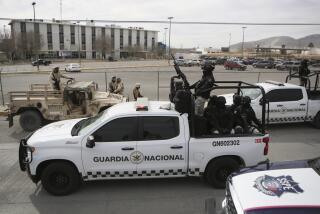13 Slain Had Fled Prison, Afghans Say
- Share via
KABUL, Afghanistan — Thirteen gunmen killed in a shootout on the southern edge of this capital were Al Qaeda members who had just broken out of prison, apparently with the help of associates, the Afghan government said Thursday.
The jailbreak Wednesday, coupled with intelligence officials’ renewed insistence that an attempted car bombing foiled last month was an Al Qaeda operation targeting Afghan President Hamid Karzai, raised concerns that the terrorist organization might be stepping up operations in Afghanistan.
With skirmishes increasingly rare in recent months, U.S. officials had been saying privately that it had become more difficult to engage Al Qaeda forces.
Initial reports on Wednesday’s shootout were sketchy, with the Afghan government taking a day to identify the escapees as members of Osama bin Laden’s terrorist group.
The prisoners--12 Pakistanis and a Kyrgyz--broke through a jail window and were given weapons, either inside or outside the jail. Foreign Minister Abdullah, who like many Afghans goes by one name, said the escapees were quickly surrounded by militia and security forces and slain after refusing to surrender. Three killed themselves with hand grenades, he said.
“They were all armed, some with grenades,” Abdullah said, adding that how and when the escapees received the weapons were unclear.
The minister said “hundreds” of Al Qaeda operatives remain in Afghan jails.
Foreign Ministry spokesman Omar Samad said the escape shows that “we are dealing with the most dangerous kinds of humans on Earth who have no qualms about killing or being killed.”
Also on Thursday, the Afghan government showed reporters the late-model Toyota station wagon that it said was packed with about 900 pounds of explosives hidden in seat cushions, side panels and the chassis.
The driver was arrested July 29 about a mile from the presidential palace in Kabul.
The driver confessed to the suicide plot, said National Security Directorate official Amrullah Saleh. The police refused to give the suspect’s name or nationality. He was briefly put on display Thursday, although reporters were not allowed to question him.
Asked whether the suspect had confessed to being a member of Al Qaeda, Saleh answered: “Who else could he be? He believes he was on a holy mission, that by doing it he would have gone directly into heaven.”
Typical of the suspicions that ripple through this tense and war-ravaged city, the belief was expressed in some circles that the bombing plot was merely a ruse manufactured by the government to demonstrate an ability to protect the interim president and other officials. That ability was left in doubt with the July 6 assassination of Vice President Haji Abdul Qadir and the subsequent decision by Karzai to replace his presidential bodyguards with U.S. troops.
If it was a ruse, the alleged crime vehicle displayed at a National Security Directorate compound was a convincing one. The plotters appeared to have gone to great lengths to avoid detection, with plastic explosives resembling cables embedded in the doors and beneath the seating.
Government technical advisor Fayd Mohammed said the car bomb had enough explosives to damage buildings more than 500 yards away. The bomb, wired to batteries, had no timer or remote control and thus “the plot was suicidal,” said Saleh, the directorate official.
Suspicion about the veracity of the car-bomb plot has been fueled by a lack of details surrounding the suspect’s capture. In addition, officials from foreign governments have not examined the car. U.S. Embassy officials here refused to comment on the case.
The Afghan government’s weak control over areas outside Kabul and the lack of any apparent successor to Karzai make keeping him protected that much more important in assuring a stable future for Afghanistan, observers have said.
More to Read
Sign up for Essential California
The most important California stories and recommendations in your inbox every morning.
You may occasionally receive promotional content from the Los Angeles Times.













